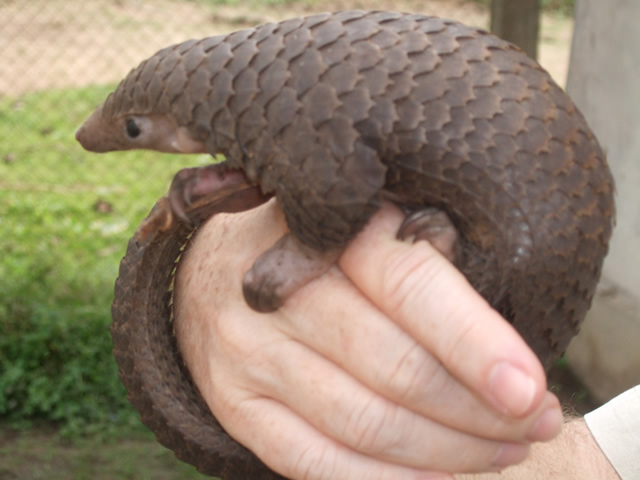Pangolins – scaly, toothless anteaters that resemble a giant walking artichoke – are being rampantly slaughtered in Southeast Asia to meet the demands of the illegal trade in pangolin flesh, scales, and fetuses.

Want to learn more about these gentle creatures? Check out this list of eleven cool facts about pangolins. Enjoy!
Meet the pangolin
- Pangolin scales are made of keratin, the same material that comprises hair and fingernail. The scales also grow continuously.
- The pangolin’s scales comprise about 20% of its weight.
- Pangolins do not have teeth. They feed on on ants and termites using a long, sticky tongue.
- Pangolins can close their ear and nostril openings to keep insects out.
- The pangolin’s tongue – when fully extended – can be up to 16 inches longer than the entire animal.
- The pangolin’s stomach grinds contents with small stones, similar to a bird’s gizzard.
- Pangolins have very poor eyesight, but an excellent sense of smell.
- Pangolins mark their territories with stinky secretions from a special gland, as well as the traditional marking methods of scattering feces and urine.
- It is estimated that one pangolin can consume in excess of 70 million insects per year.
- There are eight species of pangolin: Four Asian species and four African species.
- Baby pangolins travel with their mother by riding on the base of her tail.
Pangolin populations in decline
There are eight species of pangolin – four Asian species and four African species.
Thanks to the unfortunate belief that pangolin flesh, scales, fetuses, and body parts have medicinal properties, the Chinese Pangolin and the Sunda Pangolin are classified as Endangered.
Asian pangolin species:
- Chinese or Formosan pangolin (Manis pentadactyla) – Endangered
- Malayan or Sunda pangolin (Manis javanica) – Endangered
- Indian or thick-tailed pangolin (Manis crassicaudata) – Near Threatened
- Palawan or Philippine pangolin (Manis culionensis) – Near Threatened
African pangolin species:
- Tree or African white-bellied pangolin (Phataginus tricuspis) – Near Threatened
- Giant ground pangolin (Smutsia gigantea) – Near Threatened
- Cape or Temminck’s ground pangolin (Manis temminckii)
- Long-tailed or black-bellied pangolin (Uromanis tetradactyla)
According to the IUCN Red List of Threatened SpeciesTM, all pangolin species are experiencing decreasing populations.
Author: Rhishja Larson. Learn more about Rhishja here.
Article adapted from 11 Cool Facts About Pangolins” by Rhishja Larson, originally published 09/11/2009 on Ecolocalizer.com
Sources: Save Pangolins, African Wildlife Foundation
Image: By Valerius Tygart (Own work) via Wikimedia Commons



3 Comments
Comments are closed.